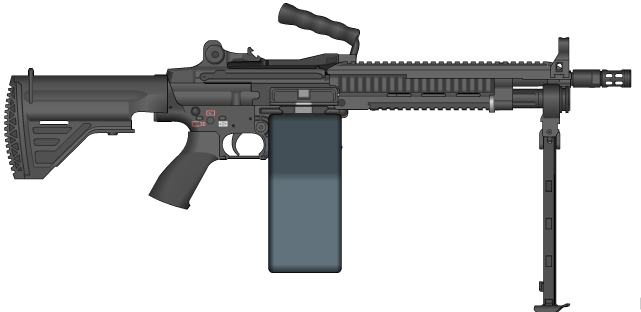KN-4 light machine gun
| KN-4 SOV | |
|---|---|
 | |
| Type | Light machine gun |
| Place of origin | Astronea |
| Service history | |
| In service | 2011-present |
| Used by | Astronean Armed Forces |
| Production history | |
| Designed | 2010 |
| Manufacturer | Obera Small Arms |
| Unit cost | $3,500 |
| Produced | 2011-present |
| Specifications | |
| Length | 1,097 mm (43.2 in) |
| Barrel length | 565 mm (22.2 in) |
| Cartridge | 7.62x51mm, 7.62x54mm, .280 ACC |
| Action | Recoil operated, roller locked |
| Rate of fire | 1100 rounds/min |
| Muzzle velocity | 820 m/s (2,700 ft/s) |
| Effective firing range | 800 m (870 yd) |
| Maximum firing range | 1,200 m (1,300 yd) |
| Feed system | 100-Round non-disintegrating belt (can be combined in a box magazine), 200-Round disintegrating belt |
| Sights | Fixed front and rear battle sight |
| References | |
SOV standing for Special Operations Variant, the KN-4 general light machine gun is purpose built for operations where weight and mobility are an issue. Equipped with full RIS for mounting sights and laser modules, a specially designed flash hider and integral bipod allows for stable, accurate and sustained fire. Polymer parts reduce the overall weight of the weapon to 6 kg, allowing it to be used effectively in a CQB environment. The KN-4 boasts a blistering 1,000 rpm, giving the user the ability suppress any target to great effect at ranges up to 800 metres.
After significant combat trials the KN-4 has seen success both domestically and abroad. For those who appreciate the large ammo capacity of 100 or even 200 round belt fed magazines, the KN-4's versatility is hard to beat. Its ability to be fielded effectively in confined spaces and in a long range area-denial suppressive capacity makes it an excellent choice for those who do not wish to field multiple machine guns for different roles.
Astronea Special Forces currently field the KN-4 in significant numbers, and is slated to replace the KN-3 AO with the Astronean Light Infantry (paras).
Design
The KN-4 is an air-cooled, belt-fed short recoil-operated firearm. It features a roller locked bolt mechanism that consists of the bolt head, a pair of rollers, the striker sleeve, bolt body and return spring. The bolt is locked securely by a wedge-shaped striker sleeve, which forces two cylindrical rollers contained in the bolt head outward, and into corresponding recesses in the extension of the breech of the barrel. On firing, both the barrel and barrel extension recoil to the rear. The resulting impact moves the carrier to the rear withdrawing the wedge and both rollers as they are cammed inward and out of their sockets by fixed cams, unlocking the bolt head. The bolt carrier and bolt then continue to the rear together guided by fixed guides while the barrel and barrel extension return to battery. Upon return of the bolt forward, the impact of the rollers against the camming surfaces on the breech carry the rollers from their seats, and, together with the surfaces on the striker sleeve, force the rollers outward, locking the bolt head into the barrel extension and ensuring a complete lock. The bolt also houses a spring-loaded casing extractor and ejector. Ejection is carried out when the ejector strikes the buffer head, sending a push forward through the ejector bar, which hits the ejector pin. This pin pushes the top of the base of the cartridge, which is still held by the extractor at the base, causing the empty casing to rotate and eject sideways via the ejection port.
The KN-4 has a quick-change, chrome-lined barrel with four right-hand grooves and a rifling twist rate of 1 in 305 mm (1:12 in). The barrel is integrated with the barrel breech. During sustained firing, there is a need for the barrel to be changed. The gun is cocked and the barrel catch on the right of the barrel shroud is swung forward. Then, the breech end of the hot barrel swings out and can be removed by elevating or twisting the gun. A fresh barrel would be inserted through the barrel catch and the muzzle bearing. When the catch is rotated back, the barrel is locked and the machine gun can resume firing.